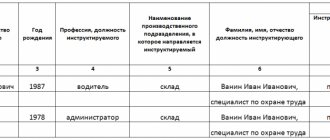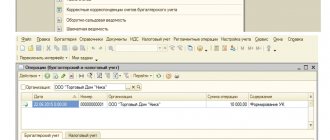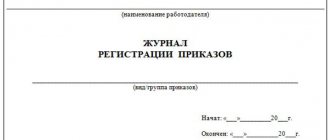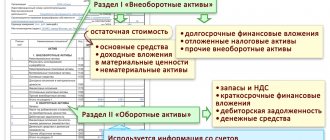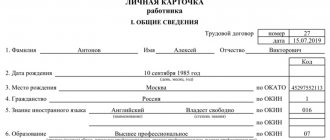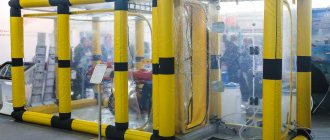Who fills out the briefing log?
The results of the briefing are entered into by the instructing person. These functions can be performed by:
- Head of the organization (introductory course);
- An employee appointed responsible for compliance with safety regulations at an enterprise or in a structural unit (all types of instruction);
- Manager of production work or personnel (all types, except introductory).
Responsibility can only be assigned to a person who has successfully completed training and certification in PTM. The frequency of the course is once every 3 years; for workers in explosion- and fire-hazardous industries, training is conducted annually.
Why do you need a fire safety training log in the workplace?
Mastering the theoretical part of safety precautions at an enterprise is a prerequisite for admitting a newly arrived employee to his workplace. In addition to introductory training, other types of classes are provided for employees, depending on their length of service at the enterprise or other special conditions. There are a total of 5 types of training for staff:
- introductory;
- primary;
- repeated;
- target;
- planned.
It is unacceptable to treat filling out the instruction registration book as a mere formality. Indeed, in the event of an emergency at the enterprise, it will confirm that training sessions were conducted with employees. And any inspection by the fire department will first require a log.
The manager or person responsible for safety is responsible for the timeliness and correctness of filling out the log. The authorized employee must have perfect knowledge of the discipline being taught and have experience working at the enterprise in question. In addition, he is required to have personal qualities that will help ensure a safe environment in the enterprise.
Important! Often, upon arrival to a new position, an employee undergoes simultaneously training in fire safety and labor protection. In such a situation, appropriate entries in separate journals are necessary.
Magazine form
A sample of filling out the fire safety briefing log is given in Appendix 1 of the Order of the Ministry of Emergency Situations No. 645 (12.12.2007). The document is an A4 book, produced at a printing house or manually (for example, on a regular printer) in compliance with approved rules.
The book must contain the following information:
- Date of the event;
- Information about the person being instructed – full name, date of birth, profession (position);
- Full name of the employee who conducted the training;
- Type of instruction;
- Reasons for conducting training (unscheduled);
- Signatures of the instructor and persons who attended the course.
The number of journals is not regulated and is determined individually based on the number of staff. At his discretion, the manager can provide one document for the whole enterprise, for each structural unit, and even for a separate event. The most practical model is 1 book for introductory instruction and 1 or more for other types of training.
Types of briefings
There are five types of fire safety training for employees:
- Introductory. It is carried out before entering the territory of the enterprise. This is carried out by an authorized fire service employee. This may be a full-time employee or an employee of the same enterprise who has the right to give lectures. The results of the conduct are recorded in the log of introductory briefing on fire safety.
- Primary. Material in this area will be read by the immediate supervisor or another person appointed by the administrative document of higher management before the employee begins to perform production tasks.
- Repeated. It is carried out at least once a year, and if the work is related to explosion- and fire-hazardous industries, then once every six months. The frequency can be regulated by internal local acts.
- Unscheduled. This type of instruction is carried out when routes are changed in the technological process, equipment is changed, as well as in the event of an accident, incident, or emergency situation that did or did not result in an accident.
- Target. When assigned to perform work unusual for his job tasks, this type of instruction is provided. For example, during hot work or related to the elimination of the consequences of a fire.
Each of the listed instructions must be properly completed.
This is interesting! What is a lie detector: polygraph - how to pass it
Preparing the journal for filling
Before keeping a fire safety log, make sure it meets the established requirements.
Firmware
The lacing instructions described below will help ensure convenient entry of results on all pages:
- Make holes (if there are none in the original form of the book);
- Pass a thin thread from the side of the title page; as lacing material you can use stitched nylon thread, twine, linen cord, etc.;
- Release the ends on the last sheet or back cover of the document;
- The ends must be at least 5 cm long to ensure complete freedom when turning pages.
Assurance
Fix the ends of the thread to the cover and apply a piece of paper on top containing the following information:
- Number of pages (sheets) of the document;
- Date of filing and fixing of the sticker;
- Information about the instructing person (full name, position/profession), as well as his signature.
Place the organization's seal on the dried piece of paper so that the imprint is present simultaneously on the sticker and the base (cover or sheet).
Numbering
The number must appear on each page. The counting is carried out from the title page or the first page with the table. Numbering can be done by hand, using a stamp or machine printing (put down immediately after printing).
Registration requirements
A sample log of fire safety instructions includes an extensive list of information about fire safety instructions. The document can be purchased at a printing house in finished form or printed and bound in an organization using an established template.
It should contain the following positions:
- date of the PPI;
- FULL NAME. an employee who has been instructed in fire safety;
- year of birth of the employee;
- position or profession of the employee;
- type of training provided;
- FULL NAME. instructor;
- signatures of the instructor and the employee who was instructed.
Document needed:
- lace;
- number before use;
- seal it by attaching on the back (to the ends of the lacing) a strip of paper on which to indicate the number of pages that are numbered and laced;
- affix the stamp so that its imprint is partially on the strip of paper. and partly on the final page.
After this, it must be certified by the signature of the manager.
Filling out fire safety logs
After the training event, the instructor must enter the relevant information in all empty cells, sign, and also make sure that all persons being instructed sign.
Error correction
When filling out the fire safety briefing log, you are not immune from mistakes. If accepted, it is necessary:
- Cross out the entire line with one straight line;
- Make an o under the crossed out line, in the column for the date of the instruction and the instructor’s signature;
- Fill in the following blank line with valid information.
The color of the paste must be selected according to the requirements for document flow.
Often, mistakes made are discovered over time, when subsequent lines have already been filled out. In this case, a similar procedure is applied - the line with the incorrect entry is crossed out, and the correct information is entered in the nearest empty line. To make it easier to find the desired entry in the future, you can highlight the crossed out line with an underline or color.
What not to do?
When filling out the document it is not allowed:
- Leave blank lines;
- Make corrections, incl. with a proofreader, crossing out one letter, an eraser, a blade and other methods;
- Tear out the sheets and glue new ones in their place with the same number;
- Make temporary notes (with erasable pen, pencil, etc.).
Based on the results of the fire safety briefing, only the fire safety log is filled out. The use of a magazine for occupational safety and health is not allowed, even when training is carried out jointly under both programs.
Nothing can be pasted into the document; additional sheets of information can simply be stored inside the journal.
About briefings
What types of fire safety training exist:
- Introductory. Conducted by a specialist authorized to conduct it before a new employee enters the facility for the first time. The latter must know all possible dangers and how to deal with them in the event of a fire. To instruct employees, instructions are approved; visual aids can also be used, a film can be watched, etc.
- Primary. And so, the employee approached the workplace. He now needs to be aware of the possible hazards he will face in the workplace. This type of instruction is carried out by the immediate supervisor. For this type of instruction, a special program is developed, according to which a summary is prepared.
- Repeated. At this type of briefing, the manager tells everything as in the primary briefing. The essence of the event is to remind you of your own safety while working. Any employee is busy producing and executing the plan and can forget about his own safety. During the training process, the employee is reminded what to do in a particular case. A training program should also be developed.
- Unscheduled. This type of instruction applies to the following situations: if new equipment and, accordingly, technological processes have been introduced; when new instructions on industrial safety are introduced; in the event of a fire; if an accident occurs. This type of instruction is provided as a reminder or when introducing new rules.
- Target. This type of instruction involves performing one-time work, for example, painting with oil paint or lighting a bitumen boiler. The employee must be instructed before performing this type of work.
All types of briefings are regulated by regulatory documents.
Storage and filing of the magazine in the archive
To protect it from external influences, place the book in a cover or store it in a folder. During breaks between training events, limit access to the magazine to unauthorized persons.
When all pages and lines are completed, mark the end date of the journal on the title page (it coincides with the date of entry on the last line). Next, the document is sent to the archive, the storage period is 10 years. From now on, access to the completed journal is prohibited for all unauthorized persons, including signed employees.
Now you know how to fill out a fire safety briefing log so that the inspectors of the Ministry of Emergency Situations and other supervisory and control authorities do not have any questions. Also, proper document maintenance will help to avoid or minimize administrative penalties in the event of emergencies or industrial accidents.
Is it necessary to keep records?
The log book is an important element of the organization's employee training process. This is a document of strict liability, which is stored at the enterprise for 10 years after complete completion.
Regulatory acts in the field of fire safety and labor protection regulate its mandatory presence in any organization, regardless of the specifics of the work and the activity being carried out.
Also, all employees of the organization, regardless of their function, must undergo training on knowledge in the field of fire safety.
Therefore, maintaining such a journal by responsible persons of the organization is mandatory.
When conducting inspections by government services (labor inspectorate, fire protection), employees have the right to request the availability of such a log and examine the correctness and correctness of its completion.
In the absence of this document or other violations when filling out (for example, if not all employees of the organization have undergone fire safety training), the competent authorities may impose an administrative fine on the organization and responsible employees for non-compliance with labor safety standards and
fire safety.
The presence of the log is also checked in the event of an emergency involving a fire.
If the event occurred through the fault of an employee who was familiar with the instructions, and there is a corresponding note, the company will not bear financial liability, and the responsible persons will not bear disciplinary liability.
Therefore, keeping a logbook is in the interests of both the employer and the employee of the organization.
How often should I fill it out?
The frequency of filling out the fire safety briefing log depends on the type of event and is divided into:
- Induction – carried out once for employees hired. In this case, the completion mark is given once for the entire period of the employee’s work.
- Primary – also carried out one-time at the workplace in relation to employees hired to deepen the knowledge acquired during induction training. During these events, responsible persons talk in detail about fire safety measures and the specifics of the enterprise’s work in relation to an individual position.
- Repeated – carried out as planned in accordance with the approved schedule. The obligation to hold such events in accordance with the law is at least 2 times a year.
- Unscheduled - carried out depending on the emergence of grounds for its implementation (the occurrence of a fire hazard, the threat of terrorist attacks or other situations in which the risk of fire increases). Therefore, when such situations arise and instructions are given, a mark is made;
- Target – carried out when an employee/group of employees changes their job function temporarily or permanently. The mark about is also affixed as it is carried out.
The frequency of filling out and making notes in the accounting log is mandatory for responsible persons.
This allows you to relieve some of the responsibility from the employer if a fire occurs due to the fault of a worker in the organization.
Who is put in charge?
A specially appointed responsible person from among the organization’s employees is responsible for filling out the fire safety logbook.
The appointment takes place in accordance with the issuance of a management order.
This person can be either an employee of the labor protection department or another employee of the organization.
A prerequisite is the presence of special education.
Obtaining this education in the field of fire safety and taking retraining courses must be completed once every 3 years.
For employees operating at enterprises with an increased risk of fire hazards, courses are required to be completed annually.
This responsible person, in addition to carrying out fire safety training, keeps records in the log after these events are carried out, ensures that it is filled out correctly and is responsible in case of its loss.
Procedure for registering fire safety instructions
The registration procedure consists of several stages:
- After carrying out fire safety training, the employee’s responsibilities include making a note about studying the set of measures. The mark is placed in the form of a signature opposite your own surname indicating the position.
- After all the marks have been made, the person responsible for conducting the briefing puts his signature. The results of activities and marks can be certified by order of the organization.
Since this journal is a document of strict accountability after making marks, and at other times it must be stored in a specially equipped place (safe) at the workplace of the responsible person.
Access to it is limited and is available only to the responsible person and the direct management of the organization.
Download the standard form and sample filling
Download the logbook and registration of fire safety briefings – word.
Sample filling when conducting fire safety instructions in the workplace - word.
Filling procedure
The following can be said about filling out training logs:
- The document is filled out without any mistakes.
- Corrections should be made carefully. Opposite each amendment you need to put an asterisk, and at the bottom opposite the asterisk, write a footnote: “believe the corrected one,” be sure to sign and write your last name.
- It is advisable to leave each page for one employee, since several instructions may have to be written here.
To fill out the log you need to:
- indicate the surname and initials of the employee, as well as position;
- write a document according to which the briefing is carried out;
- sign for the briefing and indicate the date.
Before filling out the journal, it must be taken into account in the office work of the enterprise, be sure to stitch it, and put the page number. This fact is checked especially carefully by the prosecutor's office.

